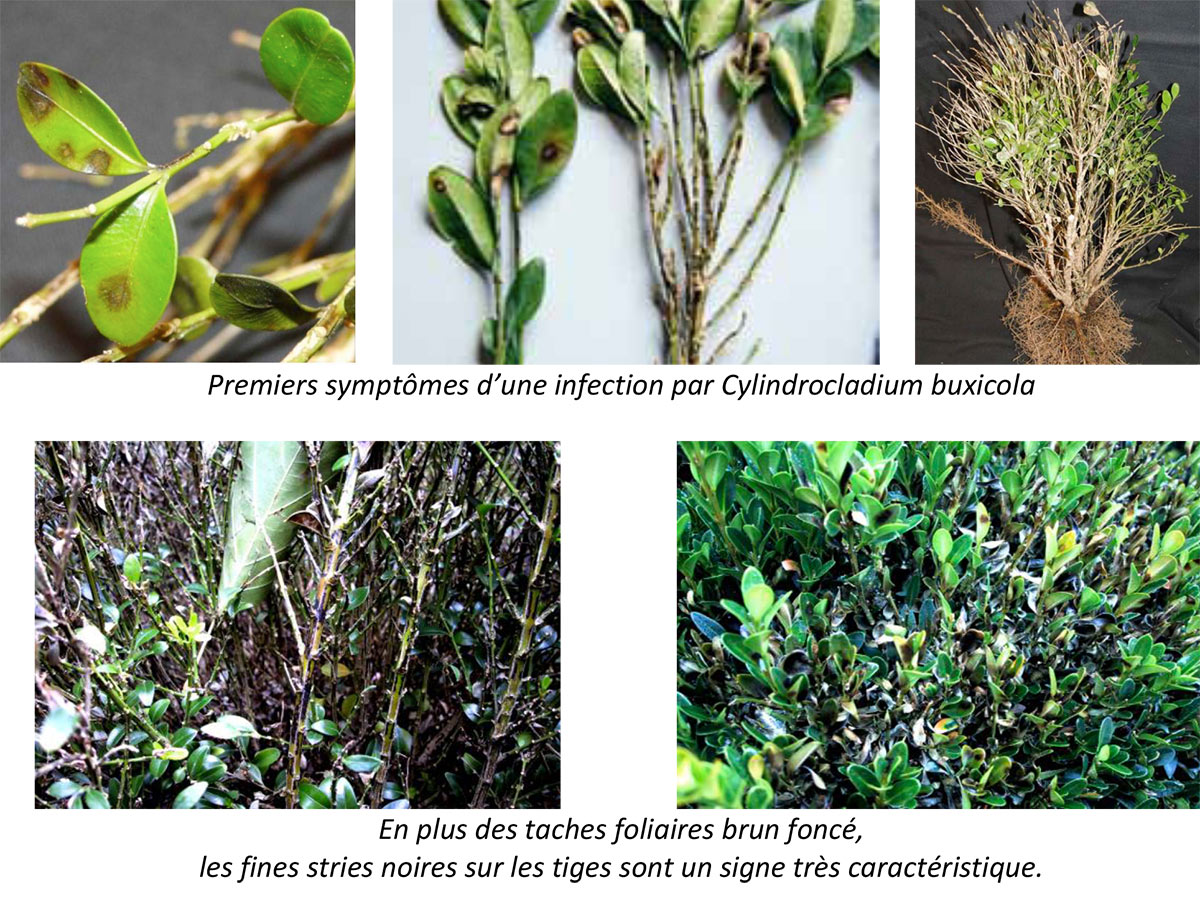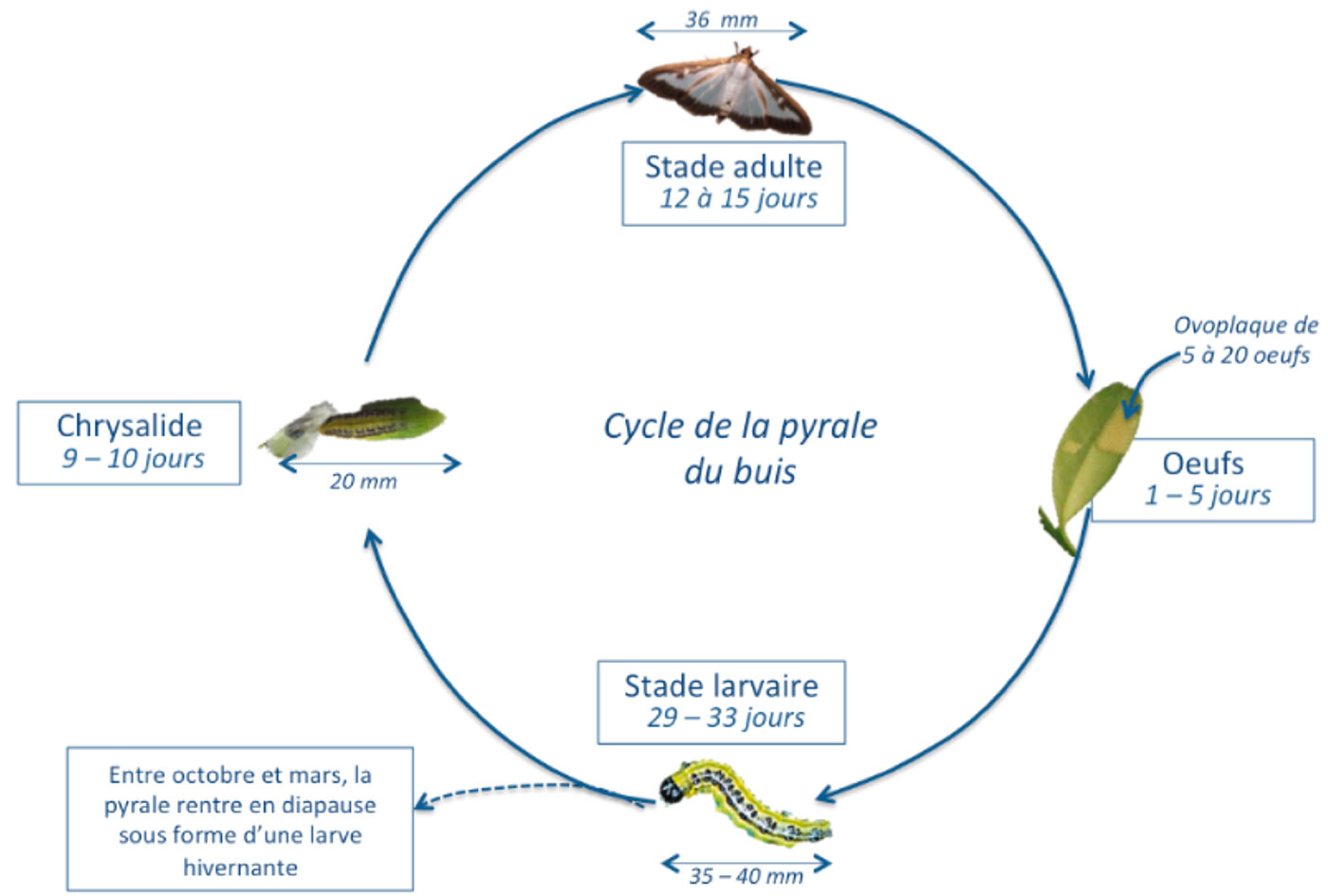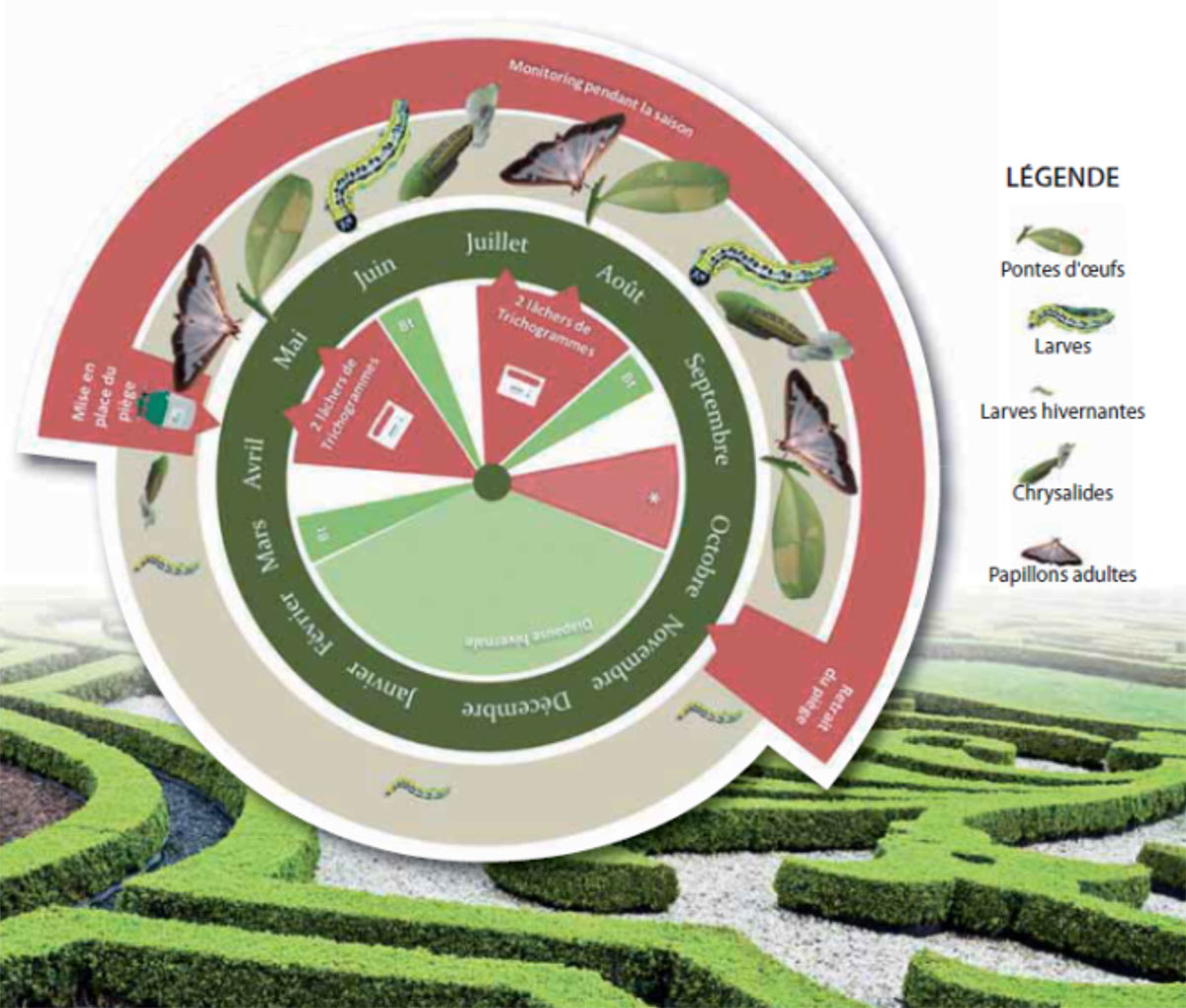Gardener’s advice
Boxwood, an easy-to-grow plant with no major problems, has become a real headache for gardeners over the last few years. Their sheer numbers on the Marqueyssac site, both in the pruned areas and in the wilder areas, make the task extremely difficult. Major efforts are being made on the site to ensure that boxwoods are protected, while at the same time keeping in line with environment and biodiversity measures, and remaining compatible with visitor requirements. The trend is increasingly towards organic methods
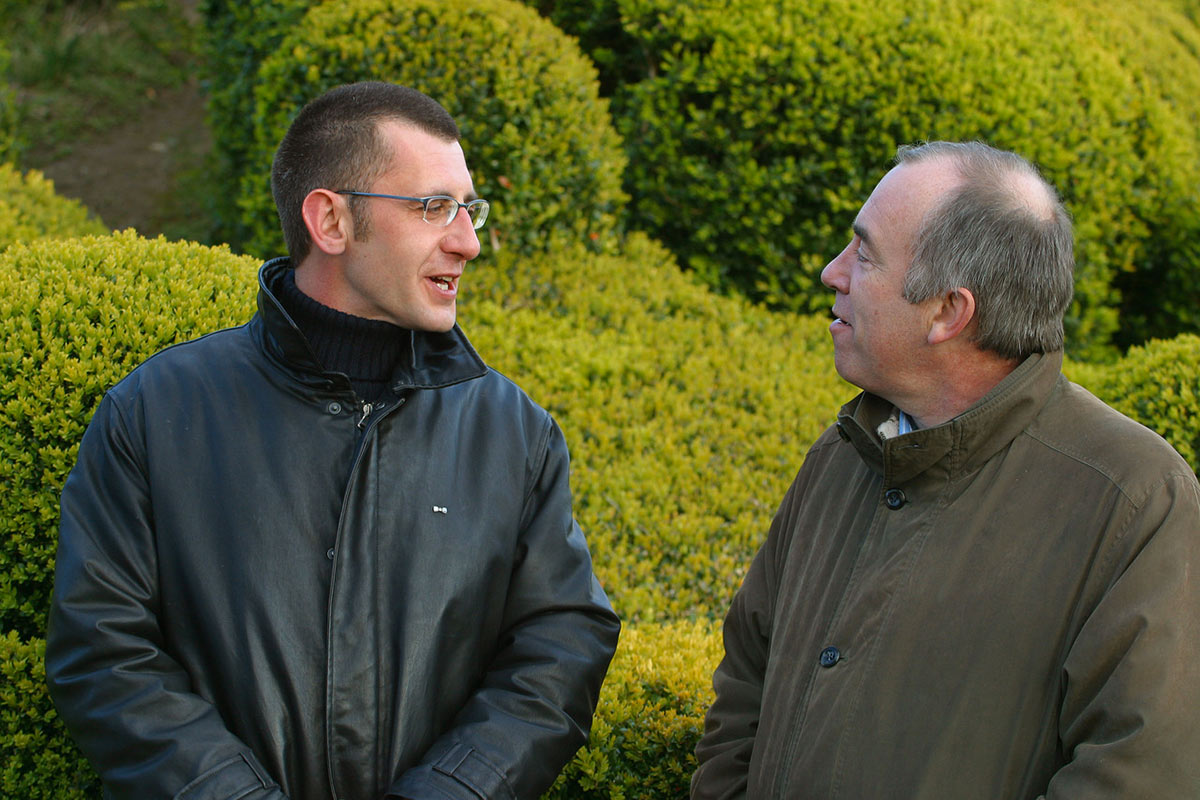
Caring for Boxwood
It’s always very tricky to give an opinion on a problem without having all the facts, and without knowing the location, its history (from the plant’s point of view) and its problems perfectly well. So these are just a few general points to help you find the right solution.
To combine aesthetics and respect for the plant, the ideal time for pruning is June, when the weather is not too hot. In this case, there’s always a little follow-up work to be done at the end of summer or in September.
However, pruning in September and even up to mid-October is perfectly suited to boxwoods, however in this case you won’t enjoy well-kept boxwoods for as long.
As well as being aesthetically pleasing, regular pruning encourages branching. Annual pruning is recommended in the first few years to reduce the current year’s growth by at least 1/3. This prevents the plant from opening up under the weight of the current year’s growth and/or water.
For versatility and excellent results, we recommend Bahco shears (the classic P51-F or P51-SL), which are used by most gardeners. The Japanese also make very good quality shears, but these are reserved for finishing use, such as the ARS shears, which are also extremely precise.
In our experience, the pruning period has no impact on either Box Caterpillar or Box Blight
When boxwoods are too large or too loose. Pruning the wood gives good results for boxwood. It is possible to go as far as cutting off the entire trunk or large branches, but the greater the amount of branching retained, the quicker the replanting will take place.
It is preferable to carry out severe pruning in January/February, outside the frost period, as this reduces the risk of frost affecting young shoots when they start up again.
Take care to make the cleanest cuts possible with sharp tools. Use a small handsaw instead of pruning shears as soon as the cross-section exceeds 7/8 mm. This will avoid splintering the bark or wood. Finally, for at least the first year after pruning and ideally for 2/3 years, make sure that your boxwoods don’t suffer from a lack of water in summer and also at the height of their growth period in spring.
A slightly lighter shade of green may be the result of a deficiency, a lack of food, the nature of the soil, etc.
Copper tints on boxwood are generally a reaction to stress, often linked to abiotic factors: drought, cold (sometimes very localised with draughts), asphyxia, etc.
The general colour, the coppery edges of the leaves, the dry tips of the leaves, dry twigs, etc. suggest plant feeding problems, which may have several causes:
- – root problems with asphyxiation: soil compaction during landscaping work, inadequate drainage with excess water in the soil (this is what boxwood fear most), etc. In these conditions, only in-depth mechanical action can solve the problem.
- – problems with sap circulation: biostimulants sprayed on the leaves or applied as a drench can help. These systemic products are supposed to work by improving the circulation of sap within the plant.
- deficiency problems: soil analyses may reveal imbalances, even locally.
The drying out and wilting of branches can be the result of various problems:
- plant feeding problems ;
- stinging insects such as mealybugs: different types of mealybug are developing more and more on boxwood, some directly on the leaves, others in the leaf axils, such as the comma mealybug;
- simply a damaged branch, a problem with animal urine (dog or cat)…
- a phytophthora problem, but this often affects a large part of the plant.
Moth attacks are not particularly linked to plant health, which is not the case for Blight.
Be careful, excessive growth with too much nitrogen in the fertiliser can result in a loose growth habit and lead to a plant with little body and a tendency to open up. A forced plant will also be more susceptible to disease. So you need to find the right balance.
Organic fertilisers in autumn are therefore preferable.
However, if you do want to fertilise, in addition to the NPK balance, it’s especially important to choose a slow-release fertiliser to limit whiplash. There are many organic fertilisers available today, and they give very good results.
Mulching limits watering and fungus problems. It will do nothing to solve plant deficiency or codling moth problems.
The main boxwood problems
Boxwood Blight: strengthening plants as a preventive measure
In recent years, attacks by boxwood-specific fungi have become a growing problem. Discovered in the UK in the mid-1990s, these diseases have spread throughout Western Europe, and since 2004 have also been observed in North America.
Two fungi in particular, Cylindrocladium buxicola and Volutella buxi, cause leaf and twig dieback. We have very little information on Volutella buxi, which we have only identified very locally in Marqueyssac and for which we have not put any specific measures in place.
Cylindrocladium buxicola, which has been our main concern in Marqueyssac since 2010, first appears as black spots on the leaves. After a few days, the infected leaves fall massively and black streaks appear on the young stems.
As was the case almost everywhere in France, Cylindrocladium buxicola caused extensive damage in Marqueyssac at the end of 2013, mainly on the north-facing slope from the Grande Allée.
The disease, which had been known on the site since 2010, had been “controlled” but not eradicated.
In October 2013, as unfortunately in many other gardens, the attack came very late in the season and was extremely virulent in a very short space of time. This attack was certainly the result of an accumulation of favourable factors: humid, mild weather conditions over several consecutive seasons and the absence of early frosts at the end of 2013.
With a very mild and wet winter, the disease showed further signs of development at the end of 2013 and the beginning of 2014, despite the treatments carried out.
It is essential to follow a number of rules:
- Good hygiene is recommended, but there is no guarantee that diseases will be contained. Avoid contact between infected and healthy plants.
- Buy healthy plants.
- Avoid damp areas that encourage infestation when planting new plants.
- Avoid watering foliage and over-fertilising.
- Mulching flowerbeds seems to limit the development of the disease by reducing the splashing of rainwater.
- Cylindrocladium buxicola can survive in the soil for many years.
– Cut off and destroy the most affected branches.
– Collect and destroy as many fallen leaves as possible. - Clean cutting tools effectively
The key is to control the disease as effectively as possible and avoid heavy outbreaks. Treatments must therefore be well targeted in relation to the risks associated with mild temperatures and humidity. In general, the most favourable times for the disease are from mid-May to mid-July and then from mid-September to the end of October. This is, of course, dependent on the year’s weather conditions, but the development of fungi on boxwood often goes hand in hand with the presence of much more desirable fungi in the woods! It is therefore essential to treat before risk periods and, in theory, every 14 days. However, we’ve never managed to keep to this 14-day schedule, and we tend to spray once a month if conditions are favourable for the fungus.
The use of fungicides is only relatively effective, and the best treatments are still those carried out as a preventive measure. In any case, when fungicides are used, they must be limited to a strict number of applications per year to limit the development of resistance.
Given the low level of chemical efficiency, Marqueyssac has made significant efforts to strengthen the natural defences of the boxwood: since 2010, plant extracts and biostimulants (BM Start, BASFOLIAR, Obstacle, Antys) have been applied, and the first trials of fermented extracts were carried out in 2015.
Lasting protection can be achieved by repeating treatments at three- to four-week intervals when conditions are favourable for the development of the fungus (commonly from April/May to September/October).
Since 2016, Cylindrocladium problems at Marqueyssac have only been “treated” by spraying plant extracts.
With the aim of strengthening the plant, fertilisers and soil improvers are applied at least once a year, mainly at the start of vegetation in March (Vegevert, Humigreen, Ever 5, organo-mineral fertilisers). Since 2020, foliar fertilisers have been added (Liquobyo, Nutrikali).
Satisfactory results to date have been achieved by regular spraying, once a month from April to October, with mixtures of nettle purin, horsetail and pure comfrey juice produced by Jean-François Lyphout (http://www.fortiech.fr).
In the event of pressure or the appearance of disease, sprays containing 20/30% and 1% black soap are applied.
Trials were carried out in 2016 with Boxwood Health without any results, with a disease declared barely a week after a spray in June. However, this attack was controlled by spraying with purins. In September 2016, a new attack (black leaves) was also blocked by a mash spray.
In addition, the stimulating effect of sprays containing 7/8% and 1% black soap is undeniable on growth and helps to stimulate a plant weakened by disease. It also promotes healing after pruning. A systematic application has been made since 2017 after each pruning. The weather sometimes makes it difficult to manage preventive or post-pruning sprays. As a result, spots of fungus always appear during high-risk periods.
Finally, trials on very localised areas have been carried out with TOP BUXUS Health Mix since 2018 and are giving good results, but at a fairly high cost. Here too, you need to work preventively, with at least one application per month (if possible, even every 3 weeks) during high-risk periods (April, May, June, September and October).
If, however, you want to opt for a chemical solution, be aware that the number of authorised products is limited and that combating the disease is not that easy.
Once again, the best treatment is prevention. Most fungicides have very limited curative action. Lasting protection can be achieved by repeating fungicide treatments at regular intervals when conditions are favourable for the development of the fungus (usually from May to September).
CAUTION: fungicides must be used sparingly and limited to a strict number of applications per year to limit the development of resistance.
Box Caterpillar: trapping as a preventive measure and ingestion products as a curative measure
This other pest, which has been wreaking havoc on box trees since its arrival in France in 2007, was first detected in Marqueyssac in the summer of 2015. That year, only a few dozen moths were caught in all the gardens. No outbreaks were detected. The caterpillars are treated with products that act by ingestion, so no treatments or other control methods were applied in 2015.
It was therefore during 2016 that the moth problem really arose on the site. Given the minute numbers of caterpillars emerging from the winter, control measures were not applied until June 2016. Two generations were observed during the 2016 season, with the first moths arriving very late due to a cool, wet spring.
Since 2017, we have systematically applied a treatment at the end of winter in order to eliminate as many caterpillars as possible from the treated areas.
At this time of year (March/April), the caterpillars are not following a butterfly flight. It is the overwintering caterpillars from the last flight of the previous year that are becoming active again. Detecting these caterpillars is difficult and requires a great deal of vigilance. The elimination of as many of these overwintering caterpillars as possible will determine the infestation for the whole of the coming season.
Despite this, 2017 was a very difficult year to manage, with very high populations. We were subjected to a heavy presence of moths in June, July and especially mid-August, with moths coming from untreated areas and the surrounding area. This resulted in a mixture of generations in July, with all stages visible (butterflies, pupae, caterpillars) for a month, which meant that we had to treat every fortnight for almost 3 and a half months.
2018 was a very different year, with few overwintering caterpillars visible, well-marked generations that made it possible to limit the number of treatments (2 treatments per flight) and a very reduced flight in August (heat at the beginning of August?), with the result that hardly any caterpillars were visible at the end of August/beginning of September.
2019 was a much quieter year for the Box Caterpillar. All the wild boxwood in the valley was decimated in 2017, so the outbreaks were smaller, but this is certainly also due to the hot weather in June, which decimated the populations.
Nevertheless, we need to remain very vigilant, as invasive species often evolve in a fairly irregular fashion.
The number of treatments was therefore further reduced in 2019. The well-marked generations made it possible to limit the number of treatments to just 1 per flight, between mid-July and mid-September.
Pressure remained the same in 2020, with very few caterpillars visible. However, the fact that the generations were spread out over time meant that we had to carry out 2 treatments at the end of June and mid-July following the first flight.
On the other hand, moth catches were very high in the last generation in August, with a “double flight peak” that suggests a resumption of activity in 2021.
pheromone trapping
Pheromone traps are very effective, but should only be used for monitoring purposes. They make it possible to monitor the generations of moths so that treatments can be triggered at the most favourable time (ideally 4/5 days after the moth flight for the first pass, then a second pass 14 days later).
This tool cannot be considered as a means of control as such. Traps are primarily used to detect the appearance of moths, so that the best possible control measures can be put in place in the days that follow.
At the start of the season (March/April), caterpillars do not follow a butterfly flight. It is the overwintering caterpillars from the last flight of the previous year that become active again.
Detecting these caterpillars is difficult and requires a great deal of vigilance. The elimination of as many of these overwintering caterpillars as possible will determine the infestation for the whole of the coming season.
Choosing the right pheromone is not always easy, as trapping efficiency can vary from one brand to another and also according to environmental conditions. Long-lasting pheromones that cover the whole season are also available.
Today, we mainly use pheromones from Bioline, which last for the usual length of time (one renewal in the middle of the season).
trichogrammes
BIOTOP markets biological control methods:
http://www.biotop.fr/16-nos-produits/lutte-biologique/155-trichotop-buxus.html
These are small wasps from indigenous strains which lay their eggs exclusively in corn borer eggs, destroying them. These strains have been used to combat the European corn borer for over 30 years.
To be effective, this biological control must be extremely precise. Two applications a week apart are required for each generation of corn borer. Studies seem to show that a good application eliminates 80-90% of the eggs from each clutch, considerably limiting the caterpillar population and hence any damage caused.
Implemented on a small scale on the first generation at the beginning of June 2016 in Marqueyssac, their effectiveness remains difficult to quantify. However, the low numbers of caterpillars in the areas tested led us to make a blanket application across the whole site for the second generation at the end of August/beginning of September. More than 10 million Trichogramma were released!
The reduced number of caterpillars at the end of this egg-laying period leads us to believe in the effectiveness of this solution.
The use of trichogramma was therefore renewed on a large scale in 2017 and 2018, with 4 applications over the entire site.
Given the limited pressure in 2019 and 2020, trichogrammes are no longer used.
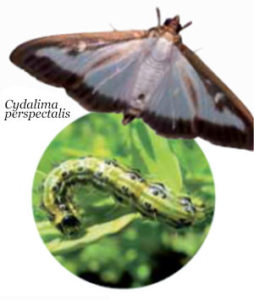 For optimum effectiveness against the Box Caterpillar, apply the Bioline integrated pest management programme:
For optimum effectiveness against the Box Caterpillar, apply the Bioline integrated pest management programme:
For optimum control, Bioline recommends acting on all stages of the pest with complementary solutions, to be deployed in three stages:
1- Adult moths: monitoring of populations by trapping using the funnel trap and Ginko® Buxus pheromone.
2- Eggs: destruction of butterfly eggs by releasing Trichogramma twice during each flight.
3- Larvae: if necessary, following observations, use Bacillus thuringiensis (not available in the Bioline range) to destroy the last remaining larvae.
Thuringian bacillus
As a complement to biological control, bacillus treatments are still essential to destroy as many residual caterpillars as possible.
Thuringian bacillus treatments work very well on Box caterpillars, provided they are applied to young caterpillars. It is therefore very important to keep a close watch on the boxwood and the traps in order to detect the appearance of moths and keep a close eye on the flight peak.
In Marqueyssac, the 2017 season also brought to light a number of difficulties, not least the need to ensure that boxwoods are well wetted when applying BT sprays in order to ensure good efficacy.
It is difficult to apply BT to the boxwood to penetrate the foliage. You need to wet the plants thoroughly and, if possible, work with good pressure or with an atomiser, which works well by agitating the foliage and thus allowing better penetration into the plant. The use of a suitable wetting agent is recommended, even if its effectiveness has not been proven.
The quantity/surface area ratio does not mean much for this type of treatment, as it depends on the quantity of boxwood, its volume, its density, etc. What counts above all is the developed surface area of foliage to be treated.
The recommendations for phytosanitary products without specific details are given for 1000 l / Ha, so for BT 1Kg/1000l/Ha. As far as we are concerned, in areas with a high density of boxwood, we use quantities of around this order.
Bacillus has a very limited duration of action. There is no remanence for BT or only a few days.
There is also sometimes a staggering of moths and therefore of egg-laying, with the appearance of young caterpillars in a staggered fashion. In these cases, it is necessary to treat regularly.
Bacillus acts by ingestion. Sprayed on the foliage, caterpillars that ingest it are destroyed in 2/3 days maximum.
Bacillus thuringiensis treatments are still the most appropriate, given their low environmental impact: this bacterium acts on the caterpillars’ digestive system after ingestion. By taking care to target spraying on boxwoods, the risks for other caterpillars are limited.
To date, all the scientific symposia held in recent years have never highlighted any BT toxicity for birds in the food chain. In urban gardens, the installation of nest boxes is even recommended.
Treatment in early spring (March/April) is necessary to eliminate caterpillars that have overwintered. It is quite difficult to position this treatment correctly, as the caterpillars do not follow a butterfly flight and start their activity with considerable delay, depending on the weather conditions. Observation is therefore the key to spotting caterpillar activity.
Secondly, while in the early years two applications two weeks apart were recommended to sweep all the egg-laying areas for each generation of moths (2 or 3 depending on the region and climate), since 2019 a single application is sufficient, applied later, around 2 weeks after the flight peak.
These biological treatments are highly effective, provided they are carried out on young caterpillars.
The overlapping generations in 2017 led us to carry out treatments every 15 days throughout the season between early June and early September! The products mentioned here are generally only available to professionals or through cooperatives (Bactura, Delfin). However, Bacillus thuringiensis is sold in garden centres under various brand names (Solabiol, etc.).
pyrethrum
Personally, I’m not in favour of the insecticides that some people recommend for treating caterpillars.
Pyrethrum is a naturally occurring insecticide, but it is TOTAL and therefore dangerous, particularly for bees. These products (Conserve, Prusik) should only be used in very specific cases of extreme urgency, such as for treating very large caterpillars (over 2.5 or even 3 cm) if monitoring has not enabled earlier action to be taken with Bacillus, or when the boxwood is largely defoliated and action needs to be taken with a contact product.
.
sexual confusion
Mating disruption methods using pheromones have been on the market since 2019. Tested in 2018 with 2 applications over an area of almost 2 ha around the château, this process involves introducing large quantities of pheromones to disrupt the reproduction of butterflies.
Like trichogramma, mating disruption limits the number of caterpillars. However, it is often necessary to treat with Thuringian Bacillus, so the process has not been repeated at Marqueyssac.
Biological means of combating the codling moth do exist. The complexity lies in applying them with the right means at the right time.
While populations have been well controlled in Marqueyssac since 2016, with no visible signs of damage, each new season is a new battle.
Today, the pruned boxwoods show no signs of moth damage. However, wild box trees outside the area open to the public were removed during the winter of 2017/2018, as they were difficult to treat and therefore created unmanageable outbreaks.
If, despite all your efforts, your boxwoods have been completely devoured, there is always a chance that they will start up again. The wisest thing to do is to wait until the following spring and then prune any branches that have not restarted. If you still want to carry out severe pruning (to limit the number of areas you need to treat, for example), it’s best to wait until February to avoid causing regrowth at the end of the season.
If your box trees still have a few leaves or are starting up again, I advise you not to touch them if you are able to treat them the following year.
Feedback on the work carried out as part of the SaveBuxus II programme “Alternatives to boxwood and management of the Boxwood Caterpillar”.
Supported by Plante & Cité, INRAe and ASTREDHOR, the SaveBuxus II programme was dedicated to boxwood alternatives and the management of the Boxwood Caterpillar.
After 4 years of work, the programme is coming to an end and the results are available here:
https://www.plante-et-cite.fr/Ressource/fiche/673
So there are high hopes for appropriate biological control.
Many thanks for all the work done over many years on this subject.

